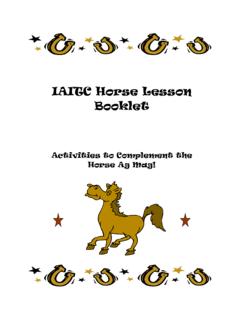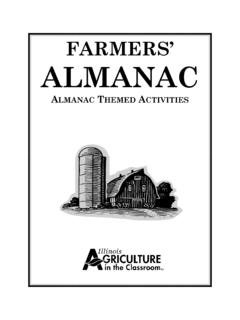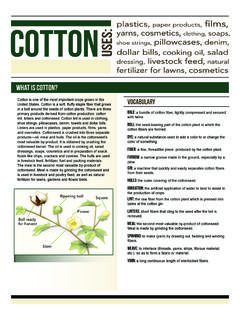Transcription of 100 Days of School, 100 Agricultural Activities! - IAITC Home
1 10 0 10 0. 1 00. 1 00. 1 00. 10 0. 100. 100 Days of School, 100 Agricultural Activities! This booklet celebrates the 100th day of school with 100. cross-curricular agriculturally-related activities. 10 0. 10 0. 10 0. 10 0. 1 00. 10 0 10 0. Celebrate 100 Days of School 100th Day festivities have been celebrated throughout schools since the school year of 1981-1982. Lynn Taylor introduced the 100th Day of School idea in the Center for Innovation in Education newsletter. Early celebrations focused on developing number sense for young children. Today, preschool children through elementary students celebrate their 100th Day of School with many cross-curricular activities. In keeping with tradition, Illinois Agriculture in the Classroom created this booklet with engaging, hands-on activities related to agri- culture for students to do on the 100th Day of School. A visual key has been created and used with each activity to indicate its subject area.
2 The topics include: hands-on, science, health and nutrition, reading, math, social studies, writing, and art. hands-on writing science reading social studies health and art nutrition math 1. Activity Reference Guide Subject Area Activity Number 1, 5, 21, 33, 45, 51, 52, 57, 59, 76, 86, 94, 97. 9, 16, 17, 19, 20, 41, 65, 93. 4, 13, 37, 38, 85, 96. 14, 31, 34, 36, 44, 46, 62, 70, 77, 80, 82, 92. 2, 3, 7, 8, 10, 15, 18, 22, 23, 40, 42, 48, 50, 54, 55, 69, 72, 73, 74, 78, 81, 87, 89, 90, 91, 99. 24, 25, 26, 27, 29, 30, 32, 39, 56, 58, 60, 61, 63, 64, 66, 67, 68, 71, 79, 88. 6, 28, 47, 49, 53, 83, 84, 98, 100. 11, 12, 35, 43, 75, 95. 2. Tallest, Free-Standing, Agriculturally Related Structure 1 Activity: Set a timer for 5 minutes and tell students to build the tallest, free-standing, agriculturally related structure they can think of using 100 Corn Packing Peanuts. After time is up, have each student share what they constructed and how it is related to agriculture.
3 Measure each structure and give the winner an ag-themed prize. Read the Corn Ag Mag. Agriculture is Everywhere 2 Activity: Divide students into several groups. Tape a large piece of paper in the front of the room. Students will look through magazines and newspapers to find people or items related to agriculture. As a class, find 100 items in all. Have students keep a class tally on the board of how many items they add. Stop every few minutes and have students count the tally marks aloud and subtract the total from 100 to see how many more items they need to find. Once there are a hundred items on the paper, talk about the objects and how they relate to agriculture. Hang the finished piece outside the classroom to re- mind everyone that Agriculture is Everywhere! Feed Sacks 3 Activity: Refer to under Lessons and Activities for ingredients and instructions for Pork Feed Sacks. In a large bowl mix 100 items of each ingredient. Stu- dents can fill a plastic snack bag using the ingredients in the bowl to create their own feed sack.
4 Read the Pork Ag Mag and discuss the different nutritional needs between humans and pigs while your students enjoy their feed sack. Snack Time 4 Activity: Eating the right snacks throughout the day is very important for students' nutrition. Have students come up with 100 different snacks that they would like to eat throughout the day. Compile one large list and have students categorize their snacks into healthy and non-healthy snacks. Have students compile a list of 100 nutritious snacks. For snack that day, provide apples as a nutritious snack and have students read the Horse Ag Mag. Discuss a horse's eating habits and why they enjoy apples as a treat. 5 Activity: 100 Facts About Agriculture Challenge students to list 100 facts they know about agriculture. Then, prepare 100. paper slips using a variety of colors. Have each student write a fact on a slip of paper and construct a paper chain. Hang the paper chain in the classroom to show off your class's Ag knowledge.
5 3. Farm Animals 6 Activity: On a piece of paper have each student list as many farm animals as they can in 100 se- conds. Discuss the animals we raise in Illinois. Read the Beef, Pork and Poultry Ag Mag, and talk about the byproducts and how we use these animals. Estimate 7 Activity: Ask students how much space 100 kernels of popcorn will take up in a glass jar. Mark estimates with a marker. Pour in popcorn kernels and discuss the differences between their estimates and the actual measurement. Ask students to share if their measurements were greater than, less than, or equal to the actual measurement. Estimate 8 Activity: Using the glass jar and popcorn kernels from the above activity, ask students how many popcorn kernels will pop; record estimates. Pop the popcorn and give each student a handful to count. Add up all students popcorn. Did all 100 pieces pop? If not, how many pieces of popcorn did pop out of the 100 kernels? Then, have students count any kernels that are left after popping.
6 Does the number of kernels match the number that is left over after the subtraction problem? Students can eat their popcorn while reading the The Water Test 9 Activity: Divide students into several small groups. Each group needs a small glass, an eye drop- per, and a small bowl of water. Have students predict the water level of 100 drops by drawing a line on the glass and initialing it. Have students take turns putting single drops into the glass until they reach 100. Each group can determine who was the closest. Take each group's glass and measure the amount of water using measuring spoons. Talk about any differences in the amounts of water in each group. Read the Water Ag Mag. (Use food coloring to make the water blue so it is easier for the students to see.). Can You Eat 100 Pieces of Popcorn? 10 Activity: Have students guess if they can eat 100 pieces of popcorn. Graph responses. Have each student count out 100 pieces of popcorn.
7 Can they eat all 100 pieces? Graph results and compare the two graphs. Read the Corn Ag Mag. Pumpkin Patch 11 Activity: Make a pumpkin thumbprint patch using orange finger paint. Have students make enough thumbprints to equal 100. Tie activity to math by making 5 rows of 10, or 3 rows of 5. Read the Pumpkin Ag Mag. 4. 100 Legs! 12 Activity: Ask students what a cow would look like with 100 legs. What about a pig, or a horse? Have each student draw a farm animal with 100 legs. Ask students what insect really has 100 legs. Talk about the centipede and how it is important for killing unwanted pests in the garden. 10 Different Exercises for a Healthy Heart 13 Activity: In the gym, set up 10 stations with activities to do 10 times each. Example activities in- clude: 10 shots with the floor hockey puck, 10 sit-ups, 10 jumping jacks, 10 ball bounc- es, 10 skips with a rope, 10 throws with beanbags into a container, 10 shots with a bas- ketball, 10 circles with a hoola hoop, 10 bounces on the small trampoline, and 10 juggles with scarves.
8 Change activity type based on the availability of different materials. Check out the Nutrition Ag Mag for more information on health and nutrition. (This Ag Mag is available on the IAITC website under Ag Mags.). One Watermelon Seed 14 Activity: Read One Watermelon Seed by Celia Barker Lottridge to students. Talk about planting seeds and what they need to grow. Ask students what they would do with 10 watermel- ons, 20 pumpkins, and so on. Create a class garden out of construction paper and have students create ten watermelons, twenty pumpkins, and so on, up to 100 ears of corn. One Watermelon Seed 15 Activity: Discuss the multiples of 10 mentioned in One Watermelon Seed by Celia Barker Lot- tridge. Give each student a tens multiplication table and go over the multiplication facts. Have students compare different groups of tens using the words greater than and less than. One Watermelon Seed 16 Activity: Plant 100 seeds (ten each of ten different types).
9 Experiment with the plants by giving one plant too much water, one not enough water, put one plant in sand, put one plant by the light, give one plant no light, etc. Have students predict which plant will grow the best and why. One Watermelon Seed 17 Activity: Create a ten-column graph (one column for each type of seed) and color in a square for each plant that sprouts. Discuss why some plants sprouted and did not. Based on re- sults, have students create a list of what they think a plant needs to grow. 5. Which Weighs More? 18 Activity: Ask students which weighs more: 100 kernels of popcorn or 100 pieces of popcorn? Have students count out100 kernels of corn and put them in a brown paper bag. Have students count out 100 pieces of popcorn and put them in a brown paper bag. Let stu- dents guess what bag contains the kernels and what bag contains the popcorn. Use a scale to find the weight of each bag. Compare estimates with actual findings.
10 Read the Corn Ag Mag. 19 Activity: Apple Prints Cut several apples in half. Divide students into small groups and have them explore the inside of an apple. Provide students with microscopes or a magnifying glass. Talk about the skin, flesh, core, and seeds and the purpose of each. Have students share what they observe. Using paint, make 100 apple prints. Read the Apple Ag Mag together as a class. Apple Facts 20 Activity: After reading the Apple Ag Mag have students list 100 apple facts. Put each fact on an apple cut out and add to your 100 apple prints from the above activity to make an apple display for a bulletin board. Spots on a Cow 21 Activity: Read the Dairy Ag Mag. Use the cow print on page 22. Trace the cow print onto a large piece of paper using an overhead. Have each student bring in a milk cap. With black paint, have students put 100 spots on the cow using their milk cap. List cow char- acteristics and dairy facts on the paper around the cow.





